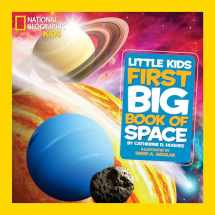
National Geographic Little Kids First Big Book of Space (National Geographic Little Kids First Big Books)
Book details
Summary
Description
This beautiful book is the latest addition to the National Geographic Little Kids First Big Book series. These colorful pages will introduce young children to the wonders of space, with colorful illustrations by David Aguilar and simple text that is perfect for beginning readers or for reading aloud. The book will explain basic concepts of space, beginning with what is most familiar to kids and expanding out into the universe.
Chapters include:
• Chapter 1 focuses on the Earth, moon, and sun.
• Chapter 2 introduces kids to the other planets in our solar system.
• Chapter 3 explains other objects in our solar system, such as dwarf planets, comets, and asteroid belts.
• Chapter 4 voyages even farther afield, touching on concepts such as the universe, the Milky Way, stars, galaxies, and black holes.
• The last chapter delves into space exploration: humans on the moon, spaceships, the International Space Station, etc.


We would LOVE it if you could help us and other readers by reviewing the book
Book review



